OTC Preview
OTC 2006 expands vistas to new depths, new horizons
Topics ranging from use of technological gains to meet burgeoning world energy needs to how the industry must cope with manpower deficits pack the schedule.
Kurt S. Abraham, Managing/ International Editor
As the world’s premier event for the global upstream industry, OTC continues to showcase innovations and innovate, itself. An ability by managing partner SPE and 21 co-sponsoring, endorsing and supporting organizations to bring new features to OTC has reinforced attendance, which hit a 20-year high in 2005. This year, the theme is “New Depths, New Horizons,” and the OTC Board has found several new ways to make this year’s experience better and more valuable for attendees.
Top among the 2006 improvements is the addition of the Pavilions exhibition section in front of Houston’s Reliant Center. There will also be “The Next Wave” session, a new venue on Thursday afternoon for professionals under 35. In addition, attendees will be able to register online until the last day of the conference. They will also be able to review, online, the first page of nearly all technical papers for free.
OTC quick facts. For the 38th straight year, OTC will be held in Houston, May 1-4, in the Reliant Park complex. Attendance in 2005 reached 51,320, and the number of attendees, representing 110-plus countries, should equal or exceed that number next month.
Encompassing permanent space inside the Reliant Center plus the traditional outdoor stands, total exhibit space will be 398,000 sq ft. In addition, another 55,000 sq ft has been made available in the new Pavilions section in front of the outdoor exhibits. More than 2,120 companies representing nearly 30 countries are likely to exhibit. The technical program should again top out at more than 300 presentations.
Registration changes. Last year, OTC implemented two on-site changes in the registration process. First, there were additional self-registration areas between Lobby B and D. In addition, there were three “Badge and Go” areas, where attendees could print out their badges without having to stand in line. This year, attendees can register online, right up to the conference’s last day. After registering online, an attendee will receive a bar code to print out. This bar code can then be brought on-site for scanning at registration stations throughout Reliant Center, so that the attendee can receive his or her badge quickly and more conveniently.
Pavilions section. As an immediate solution to the number of would-be exhibitors outstripping the permanent space inside the Reliant Center, the OTC Board has created Pavilions No. 1 and No. 2. These are temporary structures in the parking area, in front of the center. Adding more than 55,000 sq ft of exhibit space, the Pavilions will be completely enclosed and climate-controlled. A number of special activities are planned to encourage traffic flow through these areas. In addition, shuttle buses will stop at the Pavilions, which will have their own registration area. A diagram is available at http://www.otcnet.org/2006/pdfs/06OTCSitePlan_Pavilions.pdf.
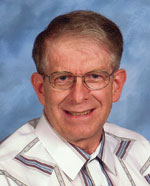 |
Peter Marshall is this year’s individual recipient of the OTC Distinguished Achievement Award.
|
|
Awards Luncheon. Peter Marshall will receive the 2006 OTC Distinguished Achievement Award for Individuals during the Awards Luncheon on Tuesday, May 2. In addition, France’s DORIS Engineering will receive the Distinguished Achievement Award for Organizations. Keynote speaker will be Petrobras Managing Director for Exploration and Production, Gilherme de Oliveira Estrella
Marshall is a consultant to offshore design firms and oil companies after spending 31 years at Shell. He will receive the individual award for “significant contributions” to the offshore industry, from shallow-water fixed platforms to ultra-deepwater floating facilities, particularly for advancements in selection, welding and inspection of steels for structures, and development of reliability-based designs.
The companies award goes to DORIS Engineering for “sustained and pioneering innovations” in design and construction of offshore facilities for nearly four decades. These include solutions to problems in frontier areas, including harsh environments, remote locations and very deep waters.
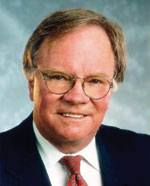 |
Matt Simmons will receive a special OTC citation for educating the world about the energy industry.
|
|
Additionally, OTC will award a special citation to Matt Simmons “for his contributions to educating the world about the energy industry and his participation in numerous insightful presentations for OTC.” Simmons is chairman and CEO of Simmons and Company International, a specialized energy investment banking firm. He authored the book, Twilight in the Desert (published last year) and is an occasional contributor to World Oil.
Topical Luncheons. Just a year ago, the number of topical luncheons was increased to 10. However, due to demand, the number of topical luncheons is rising further this year, to 13. The five luncheons on Monday, May 1 (up from four last year), include “Challenges in International Operations,” “Meeting the Challenge of Safely Developing the Energy Frontier,” “The Arc of Invention: Anticipation, to Canonical Inventor, to Exponential Growth,” “The Outer Continental Shelf: Deepwater and Frontier Opportunities and Hurricane Recovery,” and “Operator’s Perspective Luncheon Series” with Saudi Aramco Senior Vice President, E&P, Abdullah Allah S. Al-Salif.
Additionally, there will again be five luncheons on Wednesday, May 3, including “Lessons Learned from Major Offshore Incidents,” “Contributions by the Integrated Ocean Drilling Program (ODP),” “New Waves in Deep Water,” “Russian Legal Environment: Pitfalls in Providing/ Contracting Oilfield Services,” and “Indian Deepwater Exploration and Development Strategy–Operator’s Perspective Luncheon Series,” with Subir Raha, chairman of the ONGC Group of Companies.
Finally, on Thursday, May 4, the number of luncheons will rise from one to three. These sessions will include “Future of Nanotechnology in Offshore Energy Research and Technology,” “Wells of the Future: How Close is Today’s Technology?”, and “Global Warming, Consequences and Responsibilities of Oil Companies: Opportunities for the Offshore Industry.”
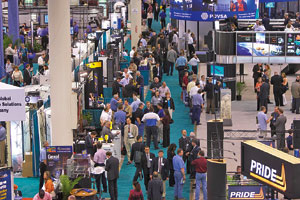 |
Mirroring a healthy industry, OTC has expanded exhibit space to beyond Reliant Center.
|
|
Industry Breakfasts. A wide variety of breakfast sessions is slated. On Tuesday, May 2, the topic is “India’s Offshore Oil and Gas Industry,” featuring Indian officials from the Directorate General of Hydrocarbons, Ministry of Petroleum & Natural Gas, Gas Authority of India Ltd. (GAIL) and Oil and Natural Gas Corporation (ONGC). These officials will highlight recent E&P activity offshore India. Their comments will also cover a new exploration licensing policy and the current fiscal environment.
On Wednesday, May 3, there will be a breakfast session entitled, “Offshore Russia Oil and Gas Opportunities,” where Russian government officials and other experts will detail the country’s plans for developing resources on its continental shelf. In addition, there will be discussion of opportunities for foreign companies, and Russia’s fiscal and regulatory regime. According to authorities, up to 4 million sq km of the Russian Continental Shelf have potential for development.
The Australian government will host a final breakfast on Thursday, May 4. This event will highlight developments, future projects and commercial opportunities in Australia’s offshore sector, including officials’ role in stimulating investment.
Energy Roundtable. In this special session on Tuesday, May 2, from 9:30 a.m. to 12 noon, an executive panel will discuss the topic, “Does the Price of Oil Have New Meaning?” Other critical issues facing the E&P industry will also be tackled by this group, moderated by RMI President Steve Jacobs. Panelists will include Guy Caruso, administrator, US Energy Information Administration; Chad Deaton, chairman and CEO, Baker Hughes; John McDonald, vice president, Strategic Planning, Chevron Corp.; Marvin Odum, executive vice president, Americas, Shell Exploration and Production, North and South America; and Robin West, founder and chairman, PFC Energy.
General Sessions. There will be two General Sessions. The first, “Reflections on an Industry in Change—Past, Present and Future,” will be held on Tuesday, May 2, from 2:00 p.m. to 4:30 p.m. It will focus on the offshore industry’s changing face and reflect on such key factors as the role of a national oil company; technology advances that have opened new frontiers; the continuing search for the most cost-efficient E&P; and the influence of crude oil pricing on global economics. In addition, the panel will examine the trend toward local content, supply chain sourcing from developing nations and the relentless search for additional personnel. Session moderator will be Amy Jaffe of the Baker Institute at Rice University. Participants will represent Anadarko Petroleum, Schlumberger, OPEC, Transocean and Accenture. The second General Session, entitled “The Challenge of Stranded Gas,” will be held on Wednesday, May 3, from 2:00 p.m. to 4:30 p.m. This session will discuss the World Bank’s Global Gas Flaring Reduction Initiative (supported by various countries) and how it ties to the issue of stranded gas reserves in such locales as Africa and Southeast Asia. To develop such reserves, regulatory constraints will have to be removed in producer countries, and either a large “anchor” project (like a power plant) or a ready-made export market will be required. For viable development of smaller reserves in remote areas, novel solutions will be required, such as CNG, or conversion to methanol or liquids by GTL processing. Panelists will represent World Bank, Noble Energy, Trans Ocean Gas Inc. and Total Exploration and Production.
Next Wave session. This new event on the afternoon of Thursday, May 4, is a special session for young professionals under age 35. It highlights the importance of transferring knowledge rapidly to this age group, especially in light of the industry’s shifting demographics. Discussion in two panel sessions will focus on leadership, career development, involvement in industry associations, etc.
The first session, “Leading the Wave of New Professionals,” features panelists from J. S. Herold, Cobalt International Energy and Microsoft. The second session, “Catching the Perfect Wave for Your Career,” has panelists from Chevron, Paradigm Geophysical and Infinistar Oilfield Services.
The first 100 registrants for The Next Wave will receive two tickets for the Thursday evening Major League Baseball game featuring the 2005 National League Champion Houston Astros and the St. Louis Cardinals.
Technical program. About 300 papers will be presented in the Technical Sessions during the four days of OTC. A sample of the topics includes:
- FPSO Technology
- Lessons learned—Hurricane Ivan
- Managed Pressure Drilling: Zeroing in on Technology
- Gulf of Mexico Under Siege: Effects of Hurricanes Katrina and Rita
- Deepwater HP/HT, HIPPS and Thermal Performance
- Applying Casing to Drilling: Moving Out
- The Development of Deepwater Ocean-Bottom Seismic: Definition to Execution.
- LNG 2006
- Hydrates as an Energy Source
- Jackup Technology Developments.
A listing of the major technical paper topics is in the table on this page. For a more detailed listing of individual papers in the technical program, please check the listings at http://www.otcnet.org/2006/tech_prog/index.html.
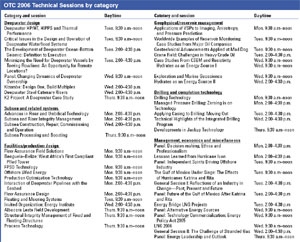 |
| Table 1 |
|
OTC 2006 Technical Sessions by category
Click image for enlarged view |
|
|
In addition, this is the first year that attendees can review the first page of nearly all technical papers for free online.
Spotlight on New Technology. In its third year, this program is recognizing 13 technologies representing 11 firms. The companies include Aker Kvaerner Subsea, Baker Oil Tools, CDS Separation Technologies, Ctour Process Systems AS, Draka Marine Oil and Gas, FMC Technologies, Halliburton’s Energy Services Group, PowerWell Services, Schlumberger, V-Tech AS and Weatherford International.
Winners were judged on four criteria. First, the technology must be “new and innovative;” less than two years old. Second, the item must have been “proven’’ through either application or successful prototype testing. Third, it must have “broad interest” and appeal for the industry. Last, each winner must make a “significant impact,” providing significant benefits beyond existing technologies.
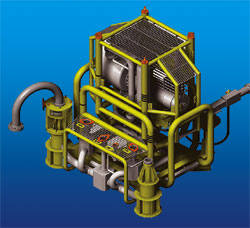 |
AkerKvaerner’s MultiBooster system
|
|
Aker Kvaerner Subsea won for its MultiBooster system, a subsea multiphase pump module. The system delivers improved oil recovery and facilitates longer step-out distances between subsea assets and host facilities by lowering reservoir pressure and increasing production line pressure. Under development since 1998, the system utilizes twin-screw internals and the firm’s pressure-volume regulator to provide a flexible, robust subsea solution. This design provides several benefits when handling multi-phase flow, including a wide performance envelope, low-shear fluid handling, stable speed-controlled operation, and efficient slug dampening.
The pump operates within a Gas Void Fraction (GVF) range of 0%-95% and can maintain pressure up to 98% GVF. For a limited period, the pump can operate at 100% GVF, which aids start-up and eliminates priming the pump during such a scenario. With typical rotational speeds of less than 2,000 rpm, there is little risk of generating emulsions, and the pump can handle very heavy, viscous fluids in excess of 1,000 centistokes. The system’s modular design allows for easier subsea installation and retrieval.
The MultiBooster system has been installed and is operational at Lyell field, offshore Scotland. Two more systems are scheduled for start-up in the Gulf of Mexico early next year.
Baker Oil Tools picked up two Spotlight awards, including Z-Seal Technology and the Smart Intervention System. Developed by Baker subsidiary Zertech Technology Ltd., the Z-Seal is a high-integrity, expandable-metal, low-profile, high-expansion seal that is entirely non-elastomeric. It operates by radically expanding the metal sealing element into contact with the tubing wall, flowing and energizing the metal into sealing contact. The seal is fully retractable and does not rely on memory. The controlled mechanism allows for expansion of up to 160%.
The complete removal of elastomers from the seal design improves packer, plug and downhole equipment performance by eliminating conventional element/ elastomer failure modes, such as explosive decompression, gasification, temperature degradation, etc. The seal has many applications, including bridge plugs, straddles, liner hangers, packers, subsea risers, etc.
In the Smart Intervention System, measurements of weight-on-tool, torque, RPM, bending moment, vibration and pressure are gathered downhole to provide a clearer picture of what is occurring at, and around, well intervention tools. Information is then transmitted to the surface, using mud pulse telemetry, and displayed clearly on a rig floor monitor.
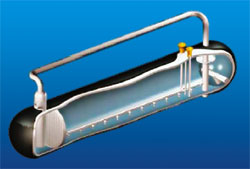 |
FMC/CDS’s compact subsea separator has integrated sand handling.
|
|
CDS Separation Technologies, an FMC Technologies subsidiary, was recognized for its Compact Subsea Separator with Integrated Sand Handling. Derived from the original subsea processing JV between CDS, FMC Kongsberg, DEMO 2000 and Statoil in 2002, this compact separator was developed to operate reliably on the seafloor throughout field life.
A core component is a patented inlet section that removes gas before the wellstream enters the separator and routes the gas through a bypass line. In this design, the inlet cyclone is positioned partially above the separator vessel. At that location, it can be sized for very high gas flowrates, compared to usual practice, where a similar inlet cyclone is positioned inside the vessel. This frees virtually the entire separator volume for oil/ water/ solids separation. This allows the separator’s physical size to be reduced by up to 50%, an important factor for lifting weight capacities of intervention ships.
Another new development in this device is sand management that removes sand from the separator vessel smoothly with low disturbance of the water phase. The compact subsea separator will be installed in phases between mid-2006 and first-half 2007 at Statoil’s Tordis field. In 2007, it will operate with a 200,000-bpd capacity.
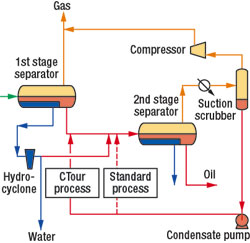 |
Components of the Ctour process.
|
|
Norway’s ProPure (formerly Ctour Process Systems) won a Spotlight award for its Ctour Process. As international regulatory standards for discharged components become stricter, the treatment of produced water is an increasingly economic and environmental concern. This new process is considered cost-effective technology that removes both dispersed oil and dissolved aromatic components from large volumes of produced water.
The technology was developed to meet the Norwegian government’s requirement for “zero harmful discharges” to sea by the end of 2005. A significant amount of the harmful items are aromatic components dissolved in the water phase, like BTEX, Naphtalens, PAHs and Phenols, and, as such, are not removed by traditional de-oiling processes, such as induced gravity decanting (hydrocyclones or centrifuges), flotation or coalescing filters.
De-oiling of produced water in a hydrocyclone/ degasser configuration yields an average discharge concentration of about 25 ppm in the Norwegian North Sea. The process is based on extraction and, when operated under optimum conditions, it yields residual oil discharges of < 2ppm while simultaneously removing 90%-95% of dissolved PAH components.
The process is commissioned for full-scale installation offshore at six different platforms in the Norwegian North Sea. These units will be in operation by 2007 and comprise a total water treating capacity of about 275,000 m3/day (1.7 million bpd). This represents two-thirds of projected produced water discharges on the NCS by 2007.
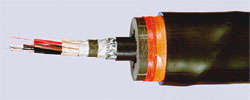 |
Draka Marine Oil and Gas was recognized for a new level in fire resistance achieved by Flex-Flame cable.
|
|
Draka Marine Oil and Gas was cited for its Flex-Flame HC 1100/30 hydrocarbon fire-resistant cable. Certified in April 2005, the cable is fire-resistant to temperatures above 1,100°C (2,000°F) for 30 min. Standard, flexible fire-resistant cables that meet IEC 60331-21, at even 1,000°C, will typically fail after 2 to 6 min. of exposure to a hydrocarbon fire at this temperature.
The new cable meets a strict requirement specified by the Norwegian Petroleum Directorate, Statoil, ExxonMobil and others. A test is done in an oven with 10 burners in the bottom of a combustion chamber. Total rating of the burners is 62,000 Btu, which can generate temperatures up to 1,300°C, or, measured a different way, more than 200 kW/m2. After passing this difficult test, ExxonMobil engineers declared that the new technology meets all their standards for hydrocarbon fires.
When fire breaks out, critical emergency systems must continue to operate. One of the potential weak links in the emergency system is the wire and cable, and its ability to withstand the extreme temperatures. By passing the 1,100°C test, with an energy of more than 200kW/m2, which is above the melting point of the copper conductor normally found in wires, the new Flex-Flame wire and cables are able to keep emergency and critical systems operating during the most challenging, dangerous conditions.
Separate from CDS, FMC Technologies was recognized for a Subsea Electric Actuator System for Manifold Retrofit. One of the emerging applications for electric actuators is retrofitting or upgrading manual chokes in subsea installations at existing fields. Retrofit applications include upgrading and expanding existing infrastructure with remotely operated valve actuators. In addition, electric actuators can override control on (horizontal) tree and manifold valves to compensate for hydraulic failures. In manifold and sled applications, usage would feature retrievable actuators, lower weight and size reductions, and simpler, local fabrication with manual valves.
Halliburton picked up a Spotlight award for its Geo-Pilot 5200 series system and 4-3/4-in. GeoTap LWD Formation Tester, used together to run the industry’s first slimhole LWD formation test in the Gulf of Mexico. This run resulted from a multi-faceted challenge handed to the service company by an operator. First, the customer’s reservoir required redrilling after completion failed on the original well. Second, real-time formation pressure sampling was required to confirm the reservoir model. Third, drilling through depleted sands presented a higher risk of differential sticking and toolface control problems with conventional steerable motors. Finally, the high wellbore inclination made wireline logging risky and potentially expensive.
The service company ran the slimhole rotary steerable system, a slimhole LWD service suite and the 4-3/4-in. formation pressure service. A reservoir re-drill was completed in one run through a milled exit in 7-5/8-in. casing, with 1,358 ft drilled. The steerable system reduced risk and helped to eliminate directional control difficulty while drilling through depleted sands. The system built and turned slightly at 3.8°/100 ft before dropping the well from 50° to 30° inclination at 3.6°/100 ft. The formation tester acquired 11 good tests in 11 attempts on this first run.
Houston-based PowerWell Services’ Power Chokes Division won for the PowerAMPS automated, managed pressure drilling (MPD) system. It addresses many long-standing drilling and wellbore stability-related issues–elimination of pressure surges when stopping/ starting circulation; improved drilling fluid management; enhanced ECD control; improved hole conditions; and, perhaps most importantly, the ability to drill more efficiently within narrow pressure environments.
The PowerAMPS system, a continuous circulation variation of MPD technology, is fed data by a hydraulics well-modeling program that reads and processes data, including drillstring rpm, ROP, drilling fluid viscosity, density and temperature, etc. It then predicts the annular pressure profile. Once the desired profile is determined, the system automatically modulates the choke, making micro-adjustments, as necessary, to compensate for changes in annular friction pressure, as flowrates increase or decrease.
The system provides better well control and achieves more precise wellbore pressure management, containment and diversion of mud returns with fewer interruptions to drilling.
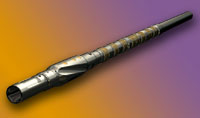 |
The EcoScope system provides simultaneous formation evaluation and drilling-related measurements.
|
|
Two items from Schlumberger were recognized—the EcoScope Multifunction Logging While Drilling Service and the QuickSilver Probe Wireline Sampling Tool. The EcoScope service uses pulsed-neutron technology to provide simultaneous formation evaluation and drilling-related measurements. It produces neutrons on demand with a pulsed neutron generator (PNG), using technology developed by Schlumberger and Japan Oil, Gas and Metals National Corporation. Its design eliminates the use of chemical sources, such as americium-beryllium, for neutron generation and removes the risks of handling, shipping and storing these sources.
Measurement of formation density without side-mounted cesium is an option, making this service the first to offer commercial LWD nuclear logging without traditional chemicals.
Design features include a single, short collar that delivers a suite of drilling and improved formation evaluation measurements from co-located sensors close to the bit. A single collar means reduced flat time associated with BHA make-up and break-up. The compact design reduces the amount of rathole that must be drilled to allow comprehensive measurements, such as elemental capture spectroscopy, sigma, porosity, gamma ray, density and resistivity.
The integrated tool design means many measurements are taken at the same depth and at the same time, under the same borehole and invasion conditions. Furthermore, built-in diagnostic chips provide information for preventative maintenance. This can significantly extend drilling footage between failures and reduce nonproductive time.
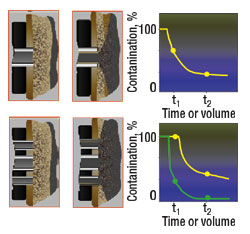 |
QuikSilver – Comparision of conventional sampling (top) and focused sampling (bottom).
|
|
Meanwhile, the company’s Quicksilver Probe wireline sampling tool was cited for addressing the problem of open-hole formation fluid analysis—uncertainty due to drilling mud filtrate contamination of sample fluid. The probe’s maximum operating temperature is 350° F (175° C), and maximum hydrostatic pressure is 25,000 psi. With knowledge of reservoir physics, an innovative tool design, and a focused sampling technique, it is now possible to achieve negligibly low contamination samples in shorter station times.
The Quicksilver Probe chart on page 72 compares conventional sampling and new, focused sampling. During conventional sampling (top illustrations), fluid withdrawn from the reservoir shows continuously diminished contamination with filtrate entering the sampling zone perimeter. Using this technique, it is theoretically impossible to achieve zero contamination in fluid samples.
With the probe’s sampling tool (bottom illustrations), pure reservoir fluid enters the center and separates from contaminated fluid entering the probe’s perimeter. Contaminated fluid is pumped into a separate flowline and isolated from pure reservoir fluid collected in a sampling flowline. This technique greatly reduces station times, due to faster cleanup, and allows first-time achievement of zero filtrate contamination during formation evaluation.
In one Gulf of Mexico case history, the operator obtained a sample 10 times cleaner than with conventional sampling, and in less time. This meant less rig time and associated risks. The operator changed drilling strategies, used a more effective oil-based mud and improved sample contamination targets from 5% to 2%. In a second case history offshore Norway, the operator achieved 0.00% contamination—down from 8%—in the same amount of pumping time.
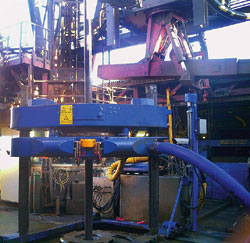 |
V-Tech’s Uni-Tong is a spinner and torque tong in one unit.
|
|
V-Tech’s Uni-Tong is a completely new power tong, concentrically parked around the drillstring. The tong combines a spinner and torque tong in one. It handles pipe dimensions from 2-3/8 to 20 in. Only three easily replaceable clamp elements handle all dimensions. A mud bucket and thread lubrication are also integrated. Use of this power tong ensures that weight, spare parts and storage capacity are reduced to a minimum. Maximum spinning speed is 60 rpm.
Recognition was granted to Weatherford International for its PowerStroke Milling System. Many wells each year are lost, due to subsidence-induced doglegs. Most problems associated with dogleg remediation stem from standard milling, using top-weighted, compressive-load conditions. Accordingly, Weatherford designed a bottom-weighted system that works under tension rather than compression.
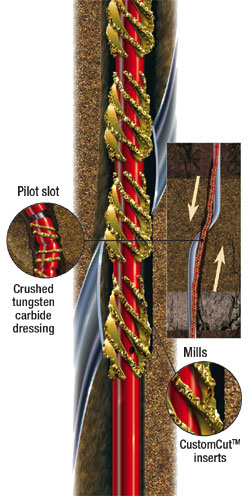 |
The PowerStroke Milling System addresses the problem of subsidence-induced doglegs.
|
|
When attempting to work a milling assembly through a convoluted casing section, it makes sense to pull it instead of trying to push it. Also, by having the weight at the milling string bottom (past the dogleg) and building some flexibility into the string, side loading can be reduced greatly. This approach also helps to eliminate sidetracking by maintaining wellbore communication throughout the dogleg. In addition, the idea of broaching the hole with a flexible broaching tool further led the team to develop this milling system. It combines a highly flexible broaching tool with a modified conventional milling tool, creating a one-trip system for repairing doglegs. Once the dogleg is repaired, a liner can be placed across it, and the well can resume production.
The tool is designed for 7-in. casing and consists of (bottom to top): flexible weight sections, broaching mill assembly, swivel sub, 12-ft stinger and the mill.
Relatively low production volumes in the first California trial wells made sidetracking and re-drilling cost-prohibitive. In many previous cases, the operator had to plug and abandon. To date, the new system has remediated seven wells with 18 doglegs. Every dogleg was repaired successfully, and the wells were brought onto production after running a liner. The company plans future deployments in Canada and Mexico for these same issues.
Winning technologies will be honored at the Spotlight on New Technology presentation on Monday, May 1, at 4:00 p.m. inside the Reliant Center. 
|














